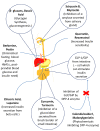Antidiabetic Phytochemicals From Medicinal Plants: Prospective Candidates for New Drug Discovery and Development
- PMID: 35282429
- PMCID: PMC8907382
- DOI: 10.3389/fendo.2022.800714
Antidiabetic Phytochemicals From Medicinal Plants: Prospective Candidates for New Drug Discovery and Development
Abstract
Diabetes, a chronic physiological dysfunction affecting people of different age groups and severely impairs the harmony of peoples' normal life worldwide. Despite the availability of insulin preparations and several synthetic oral antidiabetic drugs, there is a crucial need for the discovery and development of novel antidiabetic drugs because of the development of resistance and side effects of those drugs in long-term use. On the contrary, plants or herbal sources are getting popular day by day to the scientists, researchers, and pharmaceutical companies all over the world to search for potential bioactive compound(s) for the discovery and development of targeted novel antidiabetic drugs that may control diabetes with the least unwanted effects of conventional antidiabetic drugs. In this review, we have presented the prospective candidates comprised of either isolated phytochemical(s) and/or extract(s) containing bioactive phytoconstituents which have been reported in several in vitro, in vivo, and clinical studies possessing noteworthy antidiabetic potential. The mode of actions, attributed to antidiabetic activities of the reported phytochemicals and/or plant extracts have also been described to focus on the prospective phytochemicals and phytosources for further studies in the discovery and development of novel antidiabetic therapeutics.
Keywords: antidiabetic; antihyperglycemic; bioactive compound; diabetes mellitus; drug development; drug discovery; phytochemical; phytomedicine.
Copyright © 2022 Alam, Sarker, Sultana, Chowdhury, Rashid, Chaity, Zhao, Xiao, Hafez, Khan and Mohamed.
Conflict of interest statement
The authors declare that the study was conducted in the absence of any commercial or financial relationships that could be construed as a potential conflict of interest.
Figures
References
Publication types
MeSH terms
Substances
LinkOut - more resources
Full Text Sources
Medical



